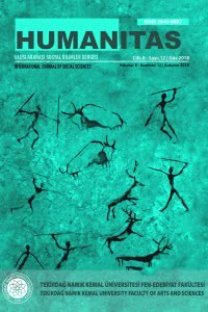KENTSEL ARKA PLANDA ÖZKİMLİK OLUŞTURMA: PORTRE VE MODERNİZMDE BİLDUNG'UN BAKIŞ AÇISINI YENİDEN ŞEKİLLENDİRMEK
Şehri hem özkimlik hem de sosyal anlamları ortaya çıkarmayı amaçlayan söylemlerinin bir parçası haline getiren yirminci yüzyıl yazarları arasında modernizmin önemli bir temsilcisi olan James Joyce önemli bir yer tutar. Portre, bu tür bir kurgunun, bir benlik kazanma için çabası içinde olan ya da daha iyi bir benlik arayışına yelken açan bireyin psikolojik bir romanı olduğunu kanıtlayan bir Bildungsroman'dır. Modernizmin öncüsü Portre’de Joyce, estetik konsantrasyonunu insan deneyiminin yeni alanlarını keşfetmek ve bireyin ön planda olduğu, özellikle psikolojik ve varoluşsal yeni sanatsal ifade yöntemleri geliştirerek edebi yeniliğe ulaşmak için kullanır. Mevcut çalışma, romanın kahramanıyla şehir kronotopu arasındaki bağlantıyı eserde biçimlendirici deneyimin sentezinin faktörü olarak ki bu romanın ayrılış ve arama ile bitmişken bildung’un (benlik veya kimlik) hala kazanılması ve oluşturulması gerektiğini ileri sürmektedir.
Anahtar Kelimeler:
Modernizm, Bildungsroman, James Joyce, psikolojik deneyim, kentsel arka plan
BUILDING SELF-IDENTITY IN URBAN BACKGROUND: PORTRAIT AND RESHAPING THE THEMATIC PERSPECTIVES OF THE BILDUNG IN THE AGE OF MODERNISM
Among the twentieth-century writers who made the city a part of their discourse aiming at revealing both self-identity and social meanings is James Joyce, a major representative of modernism. Portrait is a Bildungsroman which proves that this type of fiction is a psychological novel about an individual who strives to acquire a self, or, having a self, he or she embarks on a quest for a better self. Portrait prefigures modernism, Joyce making use of his aesthetic concentration to achieve literary innovation by exploring new fields of human experience and developing new means of artistic expression in his focus on individual, primarily psychological, existence. The present study argues about the link between the protagonist and the chronotope of the city as a factor of synthesis of the formative experience which in this novel ends in departure and search, whereas the Bildung (self or identity) is still to be acquired and asserted.
Keywords:
Modernism, Bildungsroman, James Joyce, psychological experience, urban background,
___
- Bakhtin, M. M. (1986). The Bildungsroman and its significance in the history of realism: Toward a historical typology of the novel. In C. Emorson & M. Holquist (Eds.). Speech genres and other late essays (pp. 10-59). Austin: University of Texas Press.
- Barthes, R. (1974). S/Z. New York: Hill and Wang.
- Bell, M. (1999). The metaphysics of modernism. In Michael Levenson (Ed.). The Cambridge companion to modernism. (pp. 9-32). Cambridge: Cambridge University Press.
- Bulson, E. (2006). The Cambridge introduction to James Joyce. Cambridge: Cambridge University Press.
- Castle, G.(2006). Reading the modernist Bildungsroman. Florida: University Press of Florida.
- Golban, T. (2014). Rewriting the hero and the quest: myth and monomyth in Captain Corelli’s Mandolin by Louis de Bernières. Frankfurt am Main: Peter Lang GmbH.
- Mumford, L. (1997). The culture of cities. London, Routledge.
- Oslon, L. (2009). Modernism and the ordinary. New York: Oxford University Press.
- Özmen, C. Ö. (2011). Lesser of Two Evils? Slavery in a Comparative Perspective in 19th Century American Travel Narratives of the Ottoman Empire. Mediterranean Journal of Social Sciences, 2 (3) September 2011.
- ISSN: 2147-088X
- Yayın Aralığı: Yılda 2 Sayı
- Başlangıç: 2013
- Yayıncı: Namık Kemal Üniversitesi
Sayıdaki Diğer Makaleler
İBN SÎNÂ DÜŞÜNCESİNDE BİR ERDEM OLARAK ADALET ve SOSYAL YANSIMALARI
DÎVÂNU LUGÂTİ’T-TÜRK’TEKİ su- FİİLİ ÜZERİNE
LÉVI-STRAUSS’UN YAPISALCILIĞINI ALTÜST ETMEK: CİNSİYET BELASI’NI “BÜKÜLMÜŞ BRİCOLAGE” OLARAK OKUMAK
JEAN ECHENOZ’UN BEN GİDİYORUM ROMANINDA DEĞİŞKEN ANLATI VE ANTİ-DEDEKTİF
SİYASET, SEKTE, SİYASAL: RANCIÈRE VE WOLIN
MAHREMİYETİN DÖNÜŞÜMÜ VE İLETİŞİM ARAÇLARI
ROMANTİK PARÇAYI ŞEKİLLENDİREN ŞİİRSEL İMGELEM: KUBLA KHAN VAKASI
